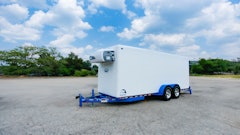
From fresh produce and meal kits to high-quality frozen meats and pet food, perishable e-commerce brands have become the proving ground for modern cold chain logistics. It’s more than moving pallets and packages from one place to another. Keeping perishables at safe temperatures until they reach a consumer’s doorstep takes more than just transportation. Furthermore, consumer preferences and lifestyles appear to reset, or at least shift, periodically. A fresh-first world demands speed, convenience, reliability, and cost-efficiency; all at once.
Cold chain innovation makes this work, ensuring fulfillment is reliable, traceable, and efficient, keeping products fresh or frozen, earning consumer trust, and supporting sustainable growth. And innovation itself isn’t static. It must continually evolve, staying aligned with today’s realities while preparing for the demands and expectations of tomorrow.
Why perishable food delivery needs dedicated tech systems
The cold chain has long been essential to pharmaceutical logistics, where precision and compliance drive every move. Yet when it comes to perishable food delivery, the requirements shift. With tighter timelines, heavy seasonal volume swings, and consumer expectations for freshness, these pressures mean food delivery has considerably less margin for holding time in the supply chain.
From origin to delivery, every step in the cold chain needs to be taken with thoughtful consideration. Temperature-sensitive products, such as fresh produce and frozen meals, can spoil or lose quality if exposed to even small fluctuations in temperature.
Delays in handling can further compromise the freshness of the products before they reach the consumer. Temperature-controlled small parcel transportation often relies on insulated liners with precise amounts of dry ice and/or frozen gel packs, while data loggers monitor conditions to ensure products stay fresh during transit. Dedicated software further supports the process by minimizing spoilage, reducing re-shipments due to mis-picks, optimizing operational costs, and maintaining compliance with safety standards.
The rising popularity of perishable e-commerce
The U.S. food e-commerce market is undoubtedly on the rise, expected to surpass $52 billion in revenue by 2024, with annual growth projected between 15-20%. Fresh food is leading the charge, making up more than half of the market and topping consumer demand, as shoppers increasingly look for convenience and high-quality products delivered straight to their door.
Consider the case of frozen foods, which were once seen as occasional or backup options, but are now becoming everyday staples. What accompanies this momentum is a shift in how consumers perceive frozen foods, as improvements to freezing technology help elevate their value as nutritious, affordable, and sustainable options.
Ready-to-cook and ready-to-eat options are growing in popularity as busy households and dual-income families look for quick, convenient ways that suit their schedules and lifestyles. Let the numbers speak for themselves: North America’s frozen food market is growing rapidly, increasing from around $103 billion in 2024 to $145 billion by 2033, at a steady pace of 4% per annum.
Then there is the meal kit phenomenon, a recent resurgence of “TV dinners” popular in the 80s and 90s, but now with a modern twist – meals developed for convenience with the health-conscious consumer in mind. Subscription-based meal kits are reshaping how people plan their meals, especially in North America, where nearly half of the global market resides. Urban lifestyles and the ease of having ingredients and recipes delivered straight to your home combine to make meal kits a popular choice today, and it shouldn’t come as a surprise when meal planning is a major stress for many American households.
For logistics providers, these trends are a full plate, loaded with opportunities, but not without a side of serious challenges – handling greater volumes of perishables that need to arrive fresh or frozen, at the right temperature, and always on time.
High shipping costs means lost revenue
Before orders can be packed and shipped, perishable e-commerce brands must look upstream to their online storefronts to convert web traffic into new and repeat customers. The food e-commerce industry has an average cart abandonment rate of 62% and one of the top reasons is high shipping costs. In order to stay competitive and maximize cart conversion rates, perishable brands need to partner with logistics providers that offer both order management systems (OMS) combined with multiple strategic locations to decrease shipping costs.
For perishable e-commerce brands shipping heavy, dry ice-filled boxes, a network of strategic distribution centers is crucial. This model significantly reduces transit times, enabling wider use of cost-effective ground shipping over expensive express options. By positioning inventory closer to customers, brands can extend their reach while minimizing the environmental impact and cost associated with air freight.
However, multiple distribution centers is only half of the equation. Utilizing intelligent, logic-based OMS software with cartonization functionality selects the correct size shipping carton for the contents of each unique order and provides real-time rate shopping to generate shipping labels using the lowest-cost carrier and service type, typically ground transit.
Order accuracy can make or break customer trust
With perishable goods, even small fulfillment errors can be costly, quickly turning what should be a positive customer experience into a loss of trust and revenue. That’s exactly why precision and dependability sit at the heart of cold chain logistics.
Smart inventory management tracks critical details, such as LOT numbers and expiration dates, for all incoming and outgoing products. Warehouse management systems (WMS) software prioritizes items closest to expiry using FEFO methods, minimizing waste while maintaining freshness. For guided, error-proof picking and packing, equipping warehouse staff with real-time digital pick lists and scanning devices ensure every item is accurately selected and packed.
Similarly, order batching for perishable fulfillment depends on a scan-based, system-driven workflow powered by WMS and OMS technologies. This integrated approach automates order validation even before items reach the warehouse floor, grouping products into efficient batches for picking based on inventory availability and ensuring that only complete, accurate orders are processed.
Now, what does it take to make sure every perishable order arrives safe for consumption and exactly as promised? The answer lies in complete end-to-end traceability, connecting every packed order to inventory LOT numbers, shipment tracking, and centralized real-time data. With this visibility, freshness, accuracy, and safety aren’t left to chance, but are intentionally built into every delivery.
Emerging tools also introduce functionality built specifically for perishables. For instance, algorithms and API calls can now calculate the precise amount of coolant needed for each parcel by factoring in the forecasted weather at its destination. This kind of automation not only safeguards product quality but also minimizes waste and improves cost efficiency.
Ultimately, perishable e-commerce is more than the sum of its parts. It thrives on the delicate interplay between what consumers want and what companies deliver, with cold chain logistics providing the steady cadence that holds it all together. The bar is constantly set and reset by consumer expectations, which is why innovation can’t stop – technology and logistics are only effective when they move in harmony with the people they serve.


















